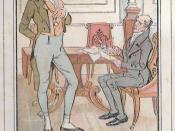Real good for a teacher that is totally into information..... One that doesn't dig persuasion. Very good. I like a report with no opinions.
Persuasion is the force exerted to influence behavior that includes a reflected change in attitude. Everyday we are bombarded with messages from people who wish to influence our behavior and attitudes. Persuasion can be used to accomplish good as well as bad, though, in my paper I will refrain from making value judgements and only report the factual aspects. I will discuss the two basic routes to persuasion, the elements involved, and ways to protect current attitudes and behaviors from change.
When trying to persuade someone, there are two different methods from which to choose- the central and peripheral routes. The central route persuades by using direct arguments and pertinent information. The peripheral route persuades people by association with incidental cues that are pleasing to the senses.
The central route is used to reach people who are more motivated and analytical, while people who are less analytical and less involved are more likely to be influenced by the peripheral route. In advertising a combination of the two is common and effective. Computer ads rely primarily on the central route, because their target audiences are perceived as highly analytical. Promotion for alcohol and tobacco products employ the peripheral route because they wish to draw attention away from the possible negative effects that they are, in reality, associated with.
To truly understand the effects of persuasion it is necessary to break the act down to its smaller components. The for elements of persuasion are 1.) The communicator, 2.) The message content, 3.) How it is communicated, and 4.) The receiver of the message.
The content of the message is important but also whoever gives the message has an...


